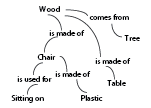
A knowledge base could be created that would reprsent the entirety of human understanding. However, when AI researchers develop knowledge bases, they generally focus on some particular domain, such as the domain of furniture, animals, restaurants and so forth.
Examples of representation languages include predicate calculus and the computer programming language LISP.
A knowledge base representing the domain of furniture should, for example, support the inference that a chair is something people sit on.